*Click here for information about Student Inventories*
Parent/Teacher Conferences — Individual parent conferences are held in December and again in May. Conferences are scheduled every 20 minutes throughout the day starting at 8am and ending at 4pm As a courtesy to all parents, conferences will not go beyond the allotted time. Parents who arrive late for their conferences will not be able to confer for the entire 20 minutes. Parents are encouraged to arrange childcare for their little ones. Conferences are always much more focused and productive when just the grown-ups are there. Plan to contact Andrea in November and again in April to schedule your conference.
Conferences may be scheduled throughout the year if a parent or the teacher feels additional meetings are warranted.
Preparing for the Conference — One of the most important pieces of conference prep work you can do is to ask your child about school. Pick a time to talk with your child when they’re not distracted and the environment is relaxed and unhurried. When you’re settling down to read a bedtime story might be the right time. Dinnertime is also a good time for conversation of any kind.
What questions should you ask? Questions that elicit more than a “yes” or “no” answer.
- Who are your friends?
- Are the kids all nice to you? (There are exceptions to the yes/no rule. Even the “best” child isn’t always nice. Humans are only capable of so much nice at 3, 4 and 5-years old! The answer will probably be, “No.” In that case, you would say, “Tell me about it.” This question lets you see how your child is handling the normal social ups and downs in a classroom. The answer can also give clues to bullying behavior your child may be experiencing that has been flying under the teacher’s radar.)
- What’s your favorite thing to do at playtime?
- What do you NOT like about school? (The answer often reflects an area of difficulty or challenge for a child. The answer can also provide clues as to what we can do to help your child have the best preschool experience possible.)
- What do you find is really hard for you to do at school? (That could be almost anything from writing with a pencil to waiting a turn for a favorite toy.)
- What’s your favorite song? What’s your favorite story? ( If the answer is “I don’t have one,” or “I don’t know,” it could be an indicator of under-engagement.)
The questions that you ask your child, and the responses your child gives, will probably help you to form the questions you want to ask the teacher during the conference.
Student Inventories — Although I monitor my students’ progress throughout the school year, two to three times a year I assess development. I am certified to administer and interpret the Gesell Developmental Examination for use in school placement, and incorporate several Gesell components in my Student Inventories. I work with each child checking literacy and math progress, fine and gross motor development, and taking developmental work samples. Except for name-writing and number-writing, these work samples do not require prior knowledge from the child.
I start the work sample portion of the inventory by having a child write their name (or any letters or marks they can write), and then (one at a time) copy a circle, square, triangle, divided rectangle, diamond, and two crosses. (See last picture below for cards from which the child copies the forms.) I end by asking the child to draw a person and then draw a tree. (Note: My 3-year old students usually copy fewer forms. Written numbers are requested from older students with experience writing numbers.)
The set of work samples pictured below was taken from Jennie, the first time when she was 3 years and 10 months old, and the second time when she was 4 years and 10 months old. You can see the leap in development Jennie took over the course of the 12-month period. (You’ll notice she needed two pieces of paper to complete the first work samples taken. Also, the numbers 1 through 10 on the second sample were written from memory, and requested by me because this was a skill Jennie had acquired over the course of the year.)
The last thing I ask a child to do is complete an incomplete person drawing. This is always a fun way to end our session as children typically love this activity. This set of pictures was done by Katie, the first when she was 4 years 6 months old, and the second when she was 6 years 2 months old. The teacher notes on the first sample include CUED: HAIR because Katie said she was finished, but hadn’t dealt with the missing hair. I pointed in the general area of the model’s head and asked if he needed anything else in that area. Katie then drew in wild hair and said the following, which I recorded on the paper: “I like guys with tall hair! Actually, it’s short, but he scared the pants out of himself!”
Aside from being a very funny remark, Katie’s words reflect her level of development. As a slightly younger child often does, she drew in the hair without regard to the hair already drawn on the model. Her comment let me know that she knew the model had shorter hair, but she was doing wild hair anyway. You’ll see the hair in the second picture is exactly like the hair already on the model. Older children usually try to match the parts they add with the parts already drawn on the model.
Twice a year, in December and again in May, I review these inventories with parents on Parent Conference Day.

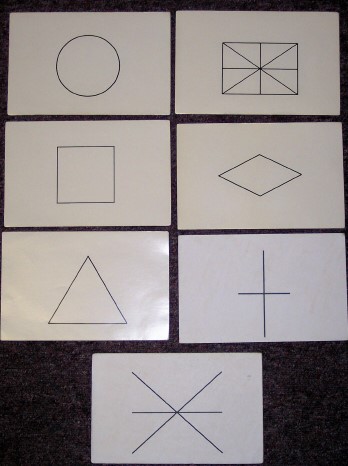
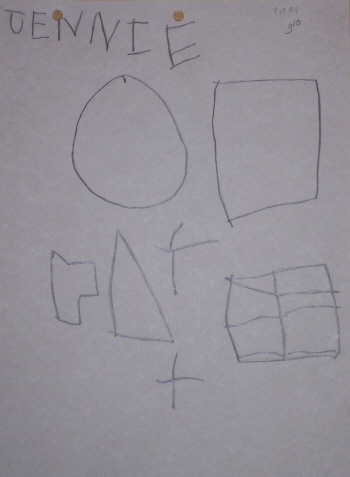
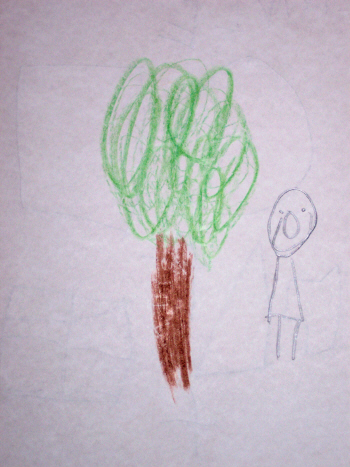
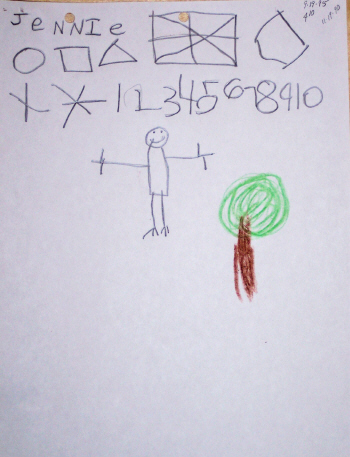

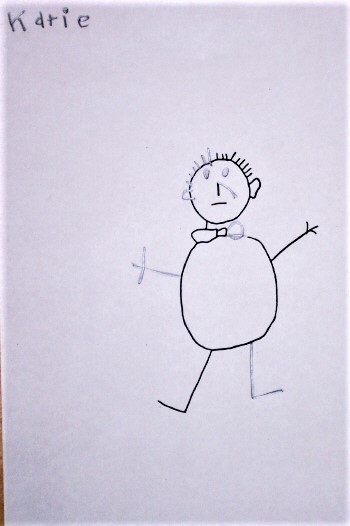
Pingback: Highlights: January 2015 | Hogarth Country Day School